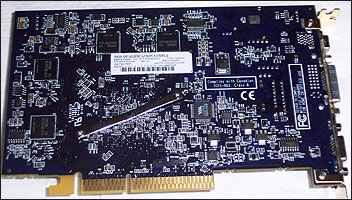ATI's Radeon X800 XT All-In-Wonder
The board
If you've ever seen an X800 XT before, the All-In-Wonder variant's board layout and appearance will be somewhat familiar. The colour scheme might not be, though. If you're looking to add a little aesthetic mayhem to your PC, look no further. For the full low-down on where the colour scheme came from, read my interview with ATI's Director of Multimedia, Godfrey Cheng.Look closely at the board and you can see the All-In-Wonder hardware. There's the packaged Microtune tuner in the top-left corner with the brand new I/O connector nearby on the backplane, white line-in feature connector to its left. Underneath the tuner on the board you'll hit AV input and output feature connectors, possibly for the addition of a daughterboard for additional I/O. Then you've got the Theater 200 IC partially hidden by the board's large heatsink and fan assembly for the GPU.
At the top of the board, above the heatsink and fan assembly, there's a revised power system for the PCB, due to the additional hardware. That suggests the original power system, which you can see here, while up to the job of powering a full four-quad R420 and Rage Theater 200, needed a little extra help in delivering clean (not necessarily more) power to the the tuner. There are heatsinked FETs, responsible for switching the input supply, for the first time on an ATI graphics board (that I know of).
On the rear of the board you can see four of the eight GC16 Samsung GDDR3 DRAM ICs that provide the 256MB of on-card memory. They're clocked at a conservative 500MHz, 83.3% of their rated frequency (600MHz).
You can then see the VT1623M video processor, which is a companion chip that while featuring its own scaling and decoding hardware, is simply responsible for the RGB SCART output handling.
Finally, the brand new I/O connector for feeding the video pipeline is visible on the backplane. It's the main reason for the product's delay and I'll explain why later in the article. That new connector, along with the smaller tuner, has enabled ATI to get DVI and VGA on the backplane for the first time on an All-In-Wonder product.
Feeding the beast
All those cables are connected to that new connector module. From left to right on this version of the connector you've got: RGB SCART output, SPDIF digital audio output, the connector for the breakout box, line-out speaker passthrough, audio input and the FM and TV antenna inputs. The breakout box is the new domino stackable style.
The pictured breakout box is input only, letting you input S-Video, composite video and stereo audio via RCA phono connector. That leaves you with a prodigious set of I/O options from the latest All-In-Wonder, to pair with the usual graphics card staple of dual monitor outputs. There are other breakout boxes for S-Video and composite output, along with RGB component output.
If there's any criticism I can level here, it's that the latest All-In-Wonder won't tune DVB-T signals in the UK (or anywhere else), leaving me to buy extra hardware to tune the now-popular free-to-air digital terrestrial television in this country. That's the same the world over, in the markets ATI is selling the X800 XT AIW into. DVB-T is a market that ATI still has to address in any of its PC-based TV tuner products, be that an All-In-Wonder or anything else. Look for their NXT range of tuner ICs to have their features augmented into future products in that area.
Otherwise, you've got a single-slot, very high performance graphics card product that can also tune TV and radio, handle digital audio output to other receivers, let you feed in S-Video, composite and stereo audio and output for the first time over SCART.
Software
Being supported by MMC9.03 means you can do MulTView (augment another MMC-supported tuner for dual feeds), you have access to the Library, FM, TV, DVD and Video CD applications that comprise MMC and access the hardware's functions and you have support from a wide-range of 3rd party software that can also control and access the hardware, such as BeyondTV and similar programs of that ilk.My apologies for not delving into MMC a little deeper, but little has changed since I looked at it last and with it due an overhaul, it doesn't deserve my harsh words about its interface yet again. It's competent, just rather ugly and a little unweildy in places.
RemoteWonder II
While unsupplied with the review sample, all signs point to retail examples of the All-In-Wonder X800 XT being shipped alongside RemoteWonder II, ATI's latest remote control package. The package comprises the remote itself, much improved over the ropey RemoteWonder I and the USB radio receiver. Range is brilliant with RemoteWonder II and the latest receiver working far beyond the limits imposed by my house and home-office and with perfect precision.Check the X800 XT AIW bundle of your chosen AIB for full details, since it's up to the AIB whether they include RemoteWonder II or not. Most likely will, but please be sure before you purchase.














